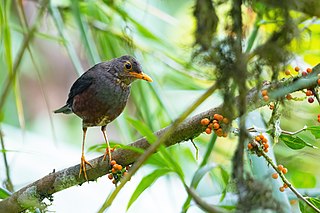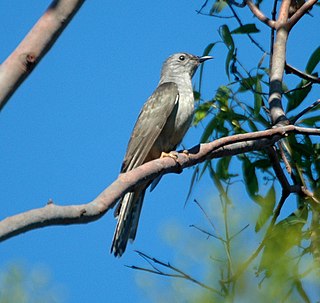
Fantails are small insectivorous songbirds of the genus Rhipidura in the family Rhipiduridae, native to Australasia, Southeast Asia and the Indian subcontinent. Most of the species are about 15 to 18 cm long, specialist aerial feeders, and named as "fantails", but the Australian willie wagtail is a little larger, and, though still an expert hunter of insects on the wing, concentrates equally on terrestrial prey.

The island thrush is a common forest bird in the thrush family. Almost 50 subspecies have been described, ranging from South East Asia and Melanesia, to Samoa, exhibiting great differences in plumage. Several subspecies are threatened and three have already become extinct.

The brush cuckoo is a member of the cuckoo family.

The white-bellied cuckooshrike is a species of bird in the family Campephagidae. It is found in Australia, the Moluccas, New Guinea and the Solomon Islands.

The Kolombangara monarch, or Brown's monarch, is a species of bird in the family Monarchidae. It is endemic to Solomon Islands. Its natural habitat is subtropical or tropical moist lowland forests. It is threatened by habitat loss.

The chestnut-bellied monarch or chestnut-bellied monarch-flycatcher is a species of bird in the family Monarchidae. It is endemic to the Solomon Islands.

The steel-blue flycatcher is a species of bird in the family Monarchidae. It is found in Papua New Guinea and Solomon Islands.

The New Zealand fantail is a small insectivorous bird, the only species of fantail in New Zealand. It has four subspecies: R. f. fuliginosa in the South Island, R. f. placabilis in the North Island, R. f. penita in the Chatham Islands, and the now-extinct R. f. cervina formerly on Lord Howe Island. It is also known by its Māori names, pīwakawaka, tīwakawaka or piwaiwaka, and the Chatham Island subspecies by the Moriori name tchitake; the common pied morph is also known as pied fantail, and the uncommon dark morph is also known as black fantail. The species has been considered by many to be conspecific as the grey fantail of Australia and New Caledonia; however, due to significant differences in its calls, many authorities now treat it as a separate species.

The oriole whistler, also known as the yellow-throated whistler, is a species of bird in the family Pachycephalidae, which is endemic to the Solomon Islands (archipelago).
The grey-capped cicadabird or Melanesian cicadabird is a species of bird in the family Campephagidae. It is endemic to the Bismarck Archipelago. It was previously considered conspecific with the common cicadabird.

The variable goshawk is a bird of prey native to Indonesia, Papua New Guinea and the Solomon Islands. It was recently elevated to species status, and was previously lumped together with the grey goshawk.
The white-gorgeted fantail is a species of bird in the family Rhipiduridae. It is endemic to the island of Malaita in the Solomon Islands. It was formerly considered as a subspecies of the white-winged fantail. Its natural habitat is subtropical or tropical moist lowland forests. It is threatened by habitat loss.
The Guadalcanal fantail is a species of bird in the family Rhipiduridae. It is endemic to the island of Guadalcanal in the Solomon Islands. It was formerly considered as a subspecies of the brown fantail. Its natural habitat is subtropical or tropical moist lowland forests. It is threatened by habitat loss.

The Fiji streaked fantail is a species of bird in the family Rhipiduridae that is endemic to the islands of Fiji. It was formerly considered to be subspecies of the streaked fantail. Its natural habitat is subtropical or tropical moist lowland forests.
The supertramp fantail is a species of bird in the family Rhipiduridae that is found on the Lesser Sunda Islands, Maluku Islands, Kai Islands and Aru Islands. It was formerly considered to be subspecies of the Arafura fantail. Its natural habitat is subtropical or tropical moist lowland forests.
The Louisiade fantail is a species of bird in the family Rhipiduridae that is endemic to the D'Entrecasteaux Islands and the Louisiade Archipelago to the east of New Guinea. This species was formerly considered to be a subspecies of the Australian rufous fantail.
The Santa Cruz fantail is a species of bird in the family Rhipiduridae that is endemic to the Santa Cruz Islands in the Pacific Ocean. It was formerly considered to be a subspecies of the Australian rufous fantail.

The Micronesian rufous fantail is a species of bird in the family Rhipiduridae that is endemic to the Mariana Islands and the island of Yap in Micronesia. It was formerly considered to be a subspecies of the Australian rufous fantail.

The Solomons rufous fantail is a species of bird in the family Rhipiduridae that is endemic to the Solomon Islands. It was formerly considered to be a subspecies of the Australian rufous fantail.














